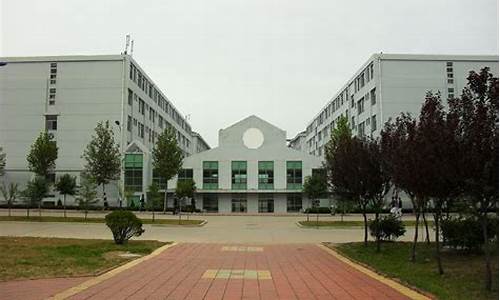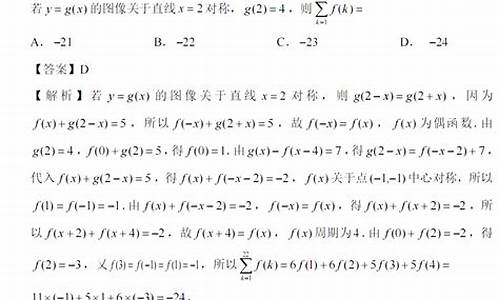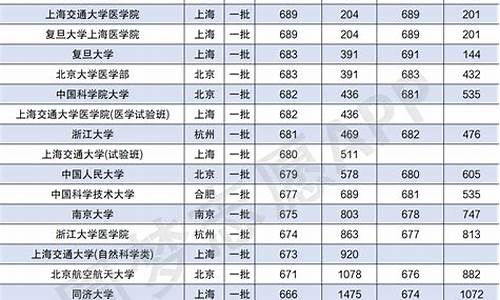您现在的位置是: 首页 > 教育改革 教育改革
倒装句高考题改错,倒装句高考题
tamoadmin 2024-06-09 人已围观
简介1.主谓倒装文言文例句2.倒装句的用法总结大全3.能不能简单的讲讲倒装句的用法(高考英语)4..The headmaster will not permit the change in the course,nor ______ it a thought.5.高考英语特殊句式有哪些《2010年高考英语语法精讲三十一 倒装句》由留学英语组我整理(www.liuxue86.com)。本内容整理时间为0
1.主谓倒装文言文例句
2.倒装句的用法总结大全
3.能不能简单的讲讲倒装句的用法(高考英语)
4..The headmaster will not permit the change in the course,nor ______ it a thought.
5.高考英语特殊句式有哪些

《2010年高考英语语法精讲三十一 倒装句》由留学英语组我整理(www.liuxue86.com)。本内容整理时间为05月12日,如有任何问题请联系我们。
全部倒装
1.由here, there引起,谓语通常用 be, come, go
Look ! Here comes your sister. There goes the bell.
2. 由介词短语引起,谓语通常用be, stand, lie, live, live, sit, come, go, rise
Along the wall stand four big chairs.
At the top of the hill lay the dying soldiers.
3. 由up, down, on, in, off, away, out, back引起,谓语通常用come, go, run, rush, fly
Out rushed the boy.
Down came the rain and up went the umbrellas.
4.以上情况主语如果是代词,主谓不倒装
Here?s your watch. (Here it is.)
Up it went.
5.由个别副词引起,谓语通常是be, lie
North of the city lies (is) a railway.
6. 由such引起, 谓语通常用be
Such is what he said. Such are his words.
部分倒装
指谓语的一部分放在主语之前而引起的倒装,通常是助动词或情态动词提前或连系动词提前
1. 由never, hardly, seldom, little, not until引起
Seldom did he make any mistakes.
Not until yesterday did I receive his letter.
2. not only?but also连接两个单句时,前面的倒装
Not only was she working hard, but also she was very polite.
3. neither?nor连接两个单句时,两个句子都倒装
Neither is he studying, nor is he working.
4. no sooner?than, hardly (scarcely)?when
No sooner had we got into the room than the telephone rang.
5. 由only + 状语, so + adj. (adv.) 引起
Only then (Only at the age of 18) did he realize the importance of the problem.
6. 由as引起
Child as he is, he can work out the problem.
7. 虚拟语气的倒装
Were I you, I would work harder.
Had you come yesterday, you would have known that.
Should it rain tomorrow, you wouldn?t leave.
so (neither, nor) + be (do, have, 情态动词,助动词)+ 主语
You should work harder and so should I.
She hasn?t been to Berlin and nor have I.
--I went to the zoo yesterday.
--So you did.
--She is a tailor.
--So is she. / So she is.
《2010年高考英语语法精讲三十一 倒装句》由留学英语组我整理(www.liuxue86.com)
主谓倒装文言文例句
? 老师叮咛:李辉老师说,想要提高作文水平,掌握正确的语法十分关键!下面的各例句都是历年真题中最常出现的、最值得同学们优先理解的虚拟语气考点!经过了全网首席高考英语名师李辉老师团队高度认真的整理校对,无错、可信!可供全国各省高中生打印、学习、背诵!
辉哥说:什么叫真努力?“觉得自己已经很努力了”或者“我比以前努力多了”都不是真努力,而往往只是自我陶醉。”所谓“真努力”,得看你:1.定了什么标准;2.有没有达到这个标准。而不是看你花了多了时间、做了多少事情。连努力的标准都没有,或者制定了标准却根本没有达到,都还是不够努力,或者根本就是自欺欺人的假勤奋、伪努力。
一、概述:
英语句子的基本语序是主语在前,谓语动词在后,当语序颠倒时就成了倒装结构。把谓语的全部放在主语之前称为完全倒装;而只把助动词或情态动词放在主语之前,则称为部分倒装。
二﹑倒装句的类型
[if !supportLists]1.?[endif] 全部倒装句:
(1)here/?there/?now/?then/?thus/out/away/up/down等副词置于句首,谓语动词常用be/come/go/?lie/run,当其主语为名词时,通常要使用倒装。
eg: a. There goes the bell.
b. Here is your letter.
c. Off goes the woman!
d. Then came the chairman.
e. Away went the boy to the school!
注意:上述全部倒装的句型结构的主语必须是名词,如果主语是人称代词则不能倒装。
eg: a.Here he comes.
b.Away they went.
(2)以引导词there开头的句子,须使用倒装结构,除there be外还有there live / stand / lie / exist等。
eg: a. There are three books on the desk.
b.There lived an old fisherman near the sea.
c.There stands a tall building in the centre of the town.
(3)so/neither/nor表示前面所述一件事也适合另一个人或物时,so用于肯定句,neither/nor用于否定句。
eg: a.Tom can speak French. So can Jack.
b.If you don't go, neither will I.
注意:
1)当so引出的句子用以对上文内容加以证实或肯定时,不可用倒装结构。意为“的确如此”。
eg: a.Tom asked me to go to play football and so I did.
b.---It's raining hard.?
---So it is.
[if !supportLists]2)?[endif]但如果上文所述两件事也适合另一个人或物,就用So it is /was with sb.或It is/was the same with sb.
eg:Marx was born in Germany and German was his native language. So it was with English.
(4)介词短语做地点状语放在句首
eg:? a.In the cottage lives a family of six.
? b.Near the bridge was an old cottage.
c.In front of the house sat a little boy.
2. 部分倒装句
(1)疑问句
eg: a.Have you seen the film?
b.When are we going to drink to your happiness
注意:如疑问词在句中做主语,则用自然语序。
eg: a. Who is your sister?
b.What is our work?
(2)?so/such...that的so/such位于句首时
eg: a.So loudly did the students read that people could hear them out in the street.
b.So small were the words that he could hardly see them.
c.Such a famous man he is that everyone wants to take a photo with him.
(3)so, neither, nor表示前面所述一件事也适合另一个人或物时,So用于肯定句,neither/nor用于否定句
eg:a.Tom can speak French. So can Jack.
b.If you don't go, neither will I.
注意:
1)当so引出的句子用以对上文内容加以证实或肯定时,不可用倒装结构。意为“的确如此”。
eg:a.Tom asked me to go to play football and so I did.?
b.---It's raining hard.
---So it is.
2)但如果上文所述两件事也适合另一个人或物,就用So it is /was with sb.或It is/was the same with sb.
eg:Marx was born in Germany and German was his native language. So it was with English
(4)否定意义的副词或短语位于句首时,常见的有:in no?way/not only…but also/never/little/rarely/seldom/hardly...when/no sooner…than/?scarcely…when/?in no case/?not...?until
eg: a. Not until the child fell asleep did the mother leave the room. b.Hardly?can?I?follow?you. c.Seldom?do?I?visit?USA. d. Never have I seen such a performance .
注意:否定词不在句首不倒装。 a. I have never seen such a performance. b. The mother didn't leave the room until the child fell asleep.
[if !supportLists](5)[endif]由as/though引导的让步状语从句。
分为表语十as+主语十系动词和动词原形+as+主语十助动词
eg: a. Young as he is, he knows some of the family
b. Try as I might, I could not lift the stone.
注意:当单数名词位于句首时,名词前无冠词。
eg:Child as he is,he knows good English.
(6)省略连词“if”的条件副词分句
eg:a.Were I you, I would not do such a thing.
? = If I were you, I would not do such a thing.
b.Would the machine break down again, send it back to us.
= If the machine would break down again, send it back to us.
c.Had you worked harder, you would have passed.
= If you had worked harder, you would have passed.
(7)有些表示“感叹、祝愿”等语气的句子,也可使用倒装结构
eg: a. Isn‘t it cold!
b.May both be happy!
c. May God bless you.
d. Long live the king!
(8)Only位于句首,强调句子的状语时
eg:a. Only then did I fully understand what my father said.
b. Only when I left school did I realize how important study is.三、倒装句应用
1.考题类型
(1)在语法填空中可能要求考生填入适当的助动词。在高考写作中恰当运用倒装句,特别是由“only+状语” 开头的倒装句,会给阅卷者留下良好的印象。
(2)在短文改错中,可能出现助动词的错用;漏掉构成部分倒装的助动词do, does或did;或者有了助动词does或did之后,谓语动词没有用原形;或者倒装句的主谓一致错误。
2.灵活运用
(1)改写句子
1)?We don’t know its value until we lose health.
?______________________ we know its value.
2)I will never forget you as long as I live.
__________I forget you as long as I live.
3)?I had no sooner gone out than it began to rain.
_____________________ than it began to rain.
4)?we can improve our English only in this way.
?______________________ improve our English.
5)We have so much homework to do that we have no time to take a rest.
___________________we have to do that we have no time to take a rest.
Answer
1)Not until we lose health do
2)Never will
3)No sooner had I gone out
4)Only in this way can we
5)So much homework do
(2)用倒装句完成句子
1)只有用这种方法,你才能学好英语。
?_______________ you learn English well.
2)她非常感激,向我点了点头。
_______________ she that she nodded to me.
3)灿烂的微笑不但使我们自己高兴,也会使他人感觉到愉悦。
?____________________ make ourselves happy, but it also enables others to feel delighted.
4)直到那时,她才意识到她没有带钱。
?_____________________that she had forgotten to take money with her.
Answer
1)Only in this way can
2)So grateful was
3)Not only can a beautiful smile
4)Not until then did she realize
(3)单句改错
1)At noon there were still no news.
2)Here is some picture-books for you.
3)If you don’t go there tomorrow, neither does Tom.
4)I didn’t see the film, and nor didn’t you.
5)I can’t swim and so can Kate.
6)He was unable to make much progress, hard although he tried.
7)Little does he realizes how important this meeting is.
8)So loudly he speak that even people in the next room could hear him.
Answer
1)were→ was ? 主语是no news,单数。
2)is→ are ? 主语是some picture-books,复数。
3)does→ will ? 主句用一般将来时。
4)didn’t→ did ? 因neither, nor本身就是否定的了,其后的助动词用肯定形式。
5)so→ neither ? 表示后者的情况同前者一样,前者是否定情况,后者用neither或nor。
6)although→ as /though ? 因although引导让步状语从句时,不能用倒装。
7)realizes→ realize ? 前面已有助动词did了,要用原形。
8)在he前加did ? 因so+ adj.位于句首时,主句用部分倒装。
倒装句的用法总结大全
1. 文言文倒装句 用法及例句
一、主谓倒装 主谓倒装句有三种情况:语气强烈的疑问句;语气强烈的感叹句;旧诗词为了韵律相合。
①子耶,言伐莒者? (言伐莒者,子耶?) ②甚矣,汝之不惠! (汝之不惠!甚矣!) ③美哉室! (室美哉!) ④大哉,尧之为君也! (尧之为君也,大哉!) ⑤灼灼其华。 (其华灼灼) ⑥竹喧归浣女,莲动下渔舟。
(竹喧浣女归,莲动渔舟下。) ⑦安在公子能急人之困也? (公子能急人之困安在也!“在安”,宾语前置) ⑧美哉,我少年中国! (我少年中国,美哉!) 以上例子分别体现了谓语前的三种情况:①⑦疑问句; ②③④⑧感叹句;⑤⑥旧诗词合韵律。
二、定语后置 定语后置有下面四种情况:1.中心语+定语+者 ①计未定,求人可使报秦者,未得。 (求可使报秦者人) ②村中少年好事者,驯养一虫。
(村中好事者少年) ③遂率子孙荷担者三夫。 (遂率荷担者子孙三夫) ④太子及宾客知其事者,皆白衣冠以送之。
(知其事者太子及宾客) ⑤人马烧溺死者甚众。 (烧溺死者人马甚众) ⑥亦雁荡具体而微者。
(亦具体而微者雁荡) ⑦客有吹洞箫者,倚歌而和之。 (有吹洞箫者客) ⑧人马冻死者相望。
(冻死者人马相望) ⑨当其时,巫行视小家女好者。 (当其时,巫行视小家好者女) ⑩楚人有涉江者 (有涉江者楚人)2.中心语+之+定语 ,“之”是定语后置的标志。
①蚓无爪牙之利,筋骨之强。 (蚓无利爪牙,强筋骨) ②居庙堂之高则忧其民,处江湖之远则忧其君。
(居高庙堂则忧其民,处远江湖则忧其君) ③四海之大,有几人欤? (大四海,有几人欤?) ④带长铗之陆离兮,冠切云之崔嵬。 (带陆离长铗,冠崔嵬切云——佩着长长的宝剑,戴着高高的切云帽)3.中心语+之(而)+定语+者,“之”是定语后置的标志 。
①石之铿然有声者,所在皆是也。 (铿然有声石,所在皆是也) ②此四者,天下之穷民而无告者。
(此四者,天下之穷民而无告者此四者,天下 之穷民而无告者) ③马之千里者,一食或尽粟一石。 (千里马) ④群臣吏民能面刺寡人之过者,受上赏。
(能面刺寡人之过者群臣吏民,受上赏) ⑤荆州之民附操者,逼兵势耳。 (附操者荆州之民) ⑥大阉之乱,缙绅而能不易其志者。
( 而能不易其志者缙绅) ⑦国之孺子之游者。 (国之游者孺子) ⑧僧之富者不能至。
(富者僧不能至)4.用数量词作定语时,数量词大多数放在中心词的后面。例如 :①吏二缚一人诣王。
(二吏二缚一人诣王) ②尝贻余核舟一。 (尝贻余一核舟) ③遂率子孙荷担者三夫。
(遂率荷担者三夫子孙) ④我持白璧一双,欲献项王;玉斗一双,欲与亚父。(一双白璧 一双玉斗) ⑤比至陈,车六七百乘,骑千余,卒数万人。
(比至陈,六七百乘车,千余骑,数万卒) ⑥一食或尽粟一石。 (一食或尽一石粟) 三、宾语前置(重点) 文言文中,动词或介词的宾语一般置于动词或介词之后,但在特定条件下宾语前置。
1.否定句中代词宾语,宾语前置。①古之人不余欺也。
(不欺余) ②三岁贯汝,莫我肯顾。 (莫肯顾我) ③我无尔诈,尔无我虞。
(我无诈尔,尔无虞我) ④每自比于管仲、乐毅,时人莫之许也。 (时人莫许之) ⑤先生……肩举驴上,而狼未之知也。
(而狼未知之也) ⑥忌不自信,而复问其妾曰…… (忌不信自)2.疑问句中疑问代词作宾语,宾语前置。①大王来何操? (大王来操何) ②沛公安在? (沛公在安) ③噫!微斯人,吾谁与归? (吾与谁归) ④夫晋,何厌之有? (夫晋,有何厌) ⑤沛公安在? (沛公在安) ⑥孔子云:“何陋之有?” (有何陋。
“之”,宾语前置标志)3.用“之”“之为”或“是”将宾语前置,用这种宾语前置的格式时,还可以在宾语之前加上“唯(惟)”,构成“唯(惟)……是……”或“惟…之…”的格式,强调宾语的作用就更大。①日居月诸,下土是冒。
(日居月诸,冒下土——日月曾经照临,阳光离去后露出了这片 *** 的土地) ②君亡之不恤,而群臣是忧。 (忧群臣) ③率师以来,唯敌是求。
(唯求敌) ④余虽与晋出入,余唯利是视。 (余唯视利) ⑤父母唯其疾之忧。
(唯其疾之忧唯其疾之忧) ⑥句读之不知,惑之不解。 (不知句读,不解惑) ⑦惟弈秋之为听。
(惟听弈秋) ⑧皇天无亲,惟德是辅。 (惟辅德) ⑨唯利是图。
(唯图利) ⑩唯吾马首是瞻。 (唯瞻吾马首) ⑾孜孜焉唯进修是急。
(唯急进修——只急迫地进德修业)4.介宾短语中宾语前置 ①不然,籍何以至此? (籍以何至此) ②全石以为底。 (以全石为底) ③长安君何以自托于赵? (长安君以何自托于赵) ④夜以继日。
(以夜继日) ⑤长安君何以自托于赵? (长安君以何自托于赵) 四、介宾短语后置(状语后置) 介词结构即介宾短语,文言文中常见的是用“以”“于”组成的介宾短语,在句中一般作状语。介宾短语后置有以下几种情况:第一种:用介词“于”组成的介宾短语在文言文中大都处在补语的位置,译成现代汉语时,除少数仍作补语外,大多数都要移到动词前作状语。
①事急矣,请奉命求救于孙将军。 (请奉命于孙将军求救) ②贫者语于富者曰…… (贫者于富者语曰) ③公与之乘,战于长勺。
(于长勺。
2. 文言文主谓倒装句需要例句的~越多越好~帮忙翻译成现代汉语主谓倒装 这种情况较为少见,往往是为了强调和突出谓语的意义,在一些句子中才出现倒装现象,这类句子一般是感叹句或疑问句.例1:“甚矣,汝之不惠.”正确语序为“汝之不惠,甚矣!”意思是“你太不聪明了.” 例2“美哉,我少年中国.” 正确语序为“我少年中国,美哉!”意思是:“我的少年中国,美丽啊.”例3“如鸣佩环” 正确语序为“如佩环鸣”,意思是:“像玉佩玉环相碰时发出的清脆声音.”例4“丰年留客足鸡豚”中的“足鸡豚”, 正确语序为“鸡豚足”,意思是:“鸡、猪丰足.”例5“卷石底以出” 正确语序为“石底卷”,意思是:“石底翻卷过来.”如果为了某种目的,把谓语放在主语的前面,并且能够恢复“主?谓”次序而意思不变的,就可以看作是主谓倒装.。
3. 主谓倒装句、宾语前置句、介宾后置句、定语后置等通俗的说是什么意1.宾语前置所谓宾语前置,就是通常作宾语的成分,置于谓语动词的前面,以示强调.如:“洎不之信”中的“之”就是前置的宾语.宾语前置通常分为四种情况.(1)疑问句中,疑问代词作宾语,宾语前置.如:“大王来何操?”(2)否定句中,代词作宾语,宾语前置.如:“古之人不余欺也.”(3)借助“之”“是”将宾语提前.如:“句读之不知,惑之不解.”“孜孜焉唯进修是急,未之多见也.”(4)介宾短语中宾语前置.如:“不然,籍何以至此?”2.定语后置通常定语应该放置于中心词的前面,但文言语句中却有很多句子将定语放在中心词之后.如:“蚓无爪牙之利,筋骨之强,上食埃土,下饮黄泉,用心一也.”其中的“利”“强”都是后置定语.文言中的定语后置有以下几种情况.(1)用“之”使定语后置.如:“四海之大,有几人欤?”(2)用“者”的后置.如:“马之千里者,一食或尽粟一石.”3.状语后置文言文中,介词结构作状语往往都会置于句后作补语.如:“贫者语于富者曰”“于富者”就是置于句后作补语的介词短语.4.主谓倒装这种情况很少,往往是为了表示强烈的感叹.如:“甚矣,汝之不惠.”“美哉,我少年中国.”[小练习]判断下列各句中的句式.①保民而王,莫之能御也.②王无异于百姓之以王为爱也.③德何如,则可以王矣?④何由知吾可也?⑤甚矣,乌纱之横,皂隶之俗哉!⑥欲祠韦苏州、白乐天诸公于其中⑦故凡为愚者,莫我若也.⑧凡人不能教子女者,亦非欲陷其罪恶.希望可以帮到楼主~①主谓倒装:“甚矣,汝之不惠”;“安在公子能急人之困?”其正常语序应该是“汝之不惠甚矣”;公子能急人之困安在?②宾语前置,这类型的倒装句也有几种形式:一是疑问句宾语前置,如“何以知之?”二是否定句中宾语前置,如“时人莫之许也”.三是其他前置,如:何功之有;唯利是图.这里的宾语前置有法可循:在疑问句或否定句中,代词作宾语可直接前置.否则就要借助“之”或“唯……是”这种形式.何以伐为?未之有也.③定语后置,如“蚓无爪牙之利,筋骨之强”.④状语后置,如“赵氏求救于齐”等.⑤介宾短语后置 冉有、季路见于孔子孙 树之以桑 申之以孝悌之义 青,取之于蓝,而青于蓝;冰,水为之,而寒于水.希望可以帮到楼主~。
4. (定语后置句宾语前置句状语后置句主谓倒装句)给个例子说明一看特殊句式 (2002·上海春季)知者创物,能者述焉. 译文是:有智慧的人开创一门新的技艺,有才能的人对之加以传承(传述). 这句话考查的重点是对“知”和“焉”的理解,如果不了解“知”字的通假现象,就丢失了一个得分点.又如: (2004·青海)每月初得禄,裁留身粮,其余悉分赈亲族,家人绩纺以供朝夕. 译文:每月初得到俸禄,仅仅留下自身口粮,其余全都分开周济亲族,家人绩麻纺线来供给早晚饮食. (2004·江苏)每曲意事二人,绩不少降节. 译文:常常违心地奉承二人,徐绩并没有稍稍降低自己的品节. 青海卷中“裁”就是通假字,通“才”,理解为“只,仅仅”.江苏卷中的“少”通“稍”,理解为“稍微,稍稍”.如果对通假现象不了解,句子就很难翻译正确. 四看古今异义 古今异义的考查近几年在文言文客观题中时有考查,并且多以古今异义的复合词出现.2001年全国题考查了“反间、南面、鼓噪、扰乱”,2002年北京题考查了“穷困”,2003年北京题考查了“具有”等等,2004年则拓展到了主观翻译题中. (2004·天津)意气益厉,乘胜逐北 译文:精神更加振奋,趁着胜利追击败兵. 句中的“意气”一词,就不能按现代汉语中的“意气”来翻译,否则失当. 五看固定结构 固定结构也是一个重要的考查点.2002年高考语文全国卷就考了这样一个句子:。
能不能简单的讲讲倒装句的用法(高考英语)
英语的倒装句是一个常考的知识点,它相对来说也比较难。学好倒装句的用法对我们的写作有很大的帮助。下面我为你们分享倒装句的用法 总结 大全。
▼▼目录▼▼
完全倒装
部分倒装
典型考题
●? 完全倒装(无需助动词)
(1) there,here,down,up,in,out,now,then,before,away,off等副词开头的 句子 ,用来表示强调(主语为人称代词时不倒装);
(2) 表示地点的介词 短语 作状语且位于句首时;
(3) 表语置于句首,强调表语或保持句子平衡时.
方法 :(1)副词+谓语+主语,副词+主语+谓语(主语为代词时不倒装);
(3) 介词短语+谓语+主语;
(4) 形容词/ed分词/-ing分词/介词短语+be+主语.
>>>
●? 部分倒装(需借助助动词)
(1) only所修饰的副词/介词短语/状语从句位于句首时(但only修饰主语位于句首时不倒装);
(2) never,hardly,seldom,scarcely,little,not…until,at no time,not once,not,no,in no time等否定意义的词位于句首时;
(3) so…that中so或such…that中such位于句首时.
方法:以上三种情况都倒装主句.
(4) 形容词/名词/动名词+as/though的让步状语从句中(although引导的让步状语从句不能倒装,though也可以不倒装);
方法:倒装从句.
(5) not only…but also连接并列分句时(连接主语时不倒装);
方法:前倒后不倒.
(6) neither…nor连接并列分句时(连接主语时不倒装);
方法:前后都倒.
(7) so位于句首表示前句的内容也同样适用于后一个人或物时(只能是肯定句,且前后两句主语不同);
方法:so+助动词+主语.
(8) neither/nor用于句首,表示前句的否定内容也适用于后一句的人/物时(只能用于否定句,且前后两句主语不同);
方法:neither/nor+助动词+主语.
(9) 表示祝愿的祈使句中:
方法:副词+谓语+主语,may+主语+谓语.
(10)在虚拟语气中,如果if条件从句有系动词were或助动词should/had,可以把其置于句首,同时省去if.
>>>
●? 典型考题
(答案分别为BBA)
1. So difficult _________ it to work out the problem that I decided to ask Tom for advice.
A. I did find B. did I find C. I have found D. have I found
2. _________ about wild plants that they decided to make a trip to Madagascar for further research.
A. so curious the couple was B. So curious were the couple
C. How curious the couple were D. The couple was such curious
3. —It’s burning hot today, isn’t it?—Yes. _________ yesterday.
A. So was it B. So it was C. So it is D. So is it
特别说明:
(1) 若前面提出某一否定的情况,要表示后者也属于同样的否定情况,则应将其中的so改为neither或nor。如:
You aren’t young and neither am I. 你不年轻,我也不年轻。
She hasn’t read it and nor have I. 她没有读它,我也没有读。
请看考题(答案选D):
Mary never does any reading in the evening, _________.
A. so does John B. John does too
C. John doesn’t too D. nor does John
(2) 注意“So+助动词+主语”与表示强调或同意的“So+主语+助动词”的区别。如:
“It was cold yesterday.” “So it was.” “昨天很冷。”“的确很冷。”
请看考题(答案分别为CD):
1.— Maggie had a wonderful time at the party. —_________, and so did I.
A. So she had B. So had she C. So she did D. So did she
2.—Father, you promised! —Well, _________. But it was you who didn’t keep your word first.
A. so was I B. so did I C. so I was D. so I did
>>>
倒装句的用法总结大全相关 文章 :
★ as的用法总结大全
★ 高中英语语法总结范文精选
★ 高二语文必修五文言文知识归纳
★ curious的用法和短语例句
★ 高中语文基本文体知识详解(2)
★ 高中语文必修知识总结归纳(2)
★ 高考语文文言文知识点总结归纳
★ 归去来兮辞知识点归纳
★ 高一下册《项脊轩志》知识点汇总
★ 过秦论知识点归纳
var _hmt = _hmt || []; (function() { var hm = document.createElement("script"); hm.src = ""; var s = document.getElementsByTagName("script")[0]; s.parentNode.insertBefore(hm, s); })();.The headmaster will not permit the change in the course,nor ______ it a thought.
倒装句用法
倒装句的意义和分类:英语的基本语序是“主语+谓语”。但有些场合是“谓语+主语”。这种语法现象称为倒装。整个谓语被放在主语的前面,称为完全倒装。例如:
There goes the bell. 铃响了。
Under a big tree sat a boy reading a book.大树下坐着一个男孩在读书。
谓语的一部分(系动词、助动词或情态动词)放在主语的前面,其余的部分仍在主语之后,称为部分倒装。
例如:
Not until 10 o'clock will the library open. 直到十点种图书馆才开门。
倒装的目的:
语法结构的需要:通常疑问句、there be 结构等需要用倒装句。例如:
Was the Communist Party of China founded in 1921? 中国***是1921年成立的吗?
There stants a bridge across the river. 河上有座桥。
Where are you going? 你上哪去?
语法修饰的需要:倒装句可以起强调作用,加强语气。例如:
Still greater contributions should we make to our motherland. 我们应该对祖国作出更大的贡献。(强调宾语)
Such is the case. 情况就是这样。(强调表语)
Now comes your turn. 现在该轮到你了。(强调状语)
Up went the model plane. 那架航模飞机飞起来了。(强调状语)
倒装句结构的基本用法:
全部倒装(平衡倒装句型):
①句首是地点状语和表语时:
In front of the house sat an old man smoking a pipe. 在房屋前面坐着一位老人在抽烟斗。(句首是状语)
On wither side of the street were rows of green trees. 街道两边绿树成行。(句首是表语)
②句首有 here, there, out, in, up, down, off, away 等副词时:
Out rushed a cat from under the table. 从桌子底下窜出一只猫来。
Here is a ticket for you. 这是给你的票。
Up went the prices. 价格上涨。
③句首有 so(表肯定),neither (nor) (表否定),表示前面所说的情况也适合与另一个人或事。
He can swim. 他会游泳。
So can she. 她也会。
He did not watch TV yesterday evening. 他昨晚没看电视。
Neither did I. 我也没看。
④在there be 结构中。
There are fifty students in our class. 我班有50个学生。
⑤在某些祝愿句中。
Long live the People's Republic of China! 中华人民共和国万岁!
⑥在某些感叹句中。
How proud we are of our great motherland! 我们为伟大的祖国感到多么自豪!
部分到装(强调倒装句型)
①用于省去if 的虚拟条件句中
Were there no air or water, there would be no life in the world.如果没有水和空气,世界上就不会有生命。
②用于以as 引导的状语从句中
Rich as they are, they are not happy. 尽管他们富有,但不幸福。
③用于句首是否定意义的副词或连词时。
Seldom have I read a novel so touching as this. 我难得读到如此动人的小说。
Hardly did I think it possible. 我几乎认为这是不可能的。
④用于疑问句。
When did you begin to learn English? 你什么时候开始学英语的?
⑤句首是only 、后边跟状语的句子中
Only in this way can you learn English well. 只有这种方法,你才能学好英语。
⑥直接引语的全部或一部分在句首时。
"Do you think my clothes fit well?" asked the emperor.“你认为我的衣服非常合身吗?”皇帝问道。
"Mr smith" said mary,"May I borrow your pen?" “史密斯先生”玛丽说,“我可以借一下你的钢笔吗?”
⑦某些祝愿的句子(谓语带有情态动词,则为部分倒装)。
May you succeed. 祝您成功。
重难点分析
1.由疑问词或有疑问词修饰的名词作主语的特殊疑问句不倒装。如:
Who is your maths teacher? 谁是你的数学老师?(who 是主语)
Which bicycle is yours? 哪辆自行车是你的?(which 是定语,修饰bicycle )
2.在以 here, there, now, then… 等开头的句子中 here, there 强调地点但不指具体的地点,只用来引起人们的注意,要重读。同样 now, then 强调时间,也并不指具体时间,只引起人们的注意,也要重读。如:
There comes our teacher. 我们的老师来了。
在时态方面要注意,除了以 then 开头的句子用过去时外,其余均用一般现在时。如:
Then came a new problem. 那时出现了新问题。
3.主语是人称代词时不倒装。如: Here we are. 我们到了。(Here are we 错)
Away he went. 他走开了。(Away went he.错)
There he comes. 他来了。(There comes he. 错)
4.为了使句子生动、流畅,常把 in, out, down, up, away, off 等,副词放在句首,采用全部倒装语序,不加助动词( do, does等)句子的动词一般都是不及物的行为动词。如:
In came the manager. 经理来了。 不说 :In did the manager come. 当主语是人称代词时,一般只把副词放在句首,不倒装。例如:
In he came and the lesson began.他进来了,于是开始上课。 不说:In came he and lesson began.
5.only 放在句首,但修饰的不是状语而是主语时,不倒装。如:
Only John is allowed to enter the lab. 只有约翰被允许进入实验室。
Only the boy himself knows what he is going to be. 只有这孩子本人知道他将来的前途。
6.以so 开头的句子。如果只是重复前面一句话的意思,不倒装。如:
It was very cold yesterday.昨天很冷。
So it was.正是这样。
He did a good job. 他干的很出色。
So he did. 确实如此。
7.以 not only 开头的句子要倒装,但but also 后面的句子不倒装。如:
Not only did he speak more correctly, but also he spoke more easily. 不仅他说得更准确,而且他说得也更轻松。
8.以 not until 开头的句子主句要倒装,没有助动词时要加助动词。如:
Not until Mother came back did it stop raining. 直到妈妈回来雨才停。
9.带有否定意义的副词和状语词组放在句首时,句子要倒装,这样的副词常见的有:no sooner…than, hardly…when, not until, never, hardly, seldom, scarecely, little, barely, at no time(=never) 等。在使用时要特别注意以hardly(barely/scarcely)…when 和 no sooner…than 开头的句子。在这种倒装句中,主句倒装从句不倒装。如:
Hardly had he got into the room when the telephone rang. 他一进屋,电话就响了。
10.频度状语如 often, seldom 等,地点状语如in front of, in the middle of 等,位于句首时,句子要倒装,没有助动词时要加助动词。如:
Seldom does it snow here.这里很少下雪。
11.充当表语的单数名词放在句首时,不加任何冠词,也不用复数形式。如:
Child as he is, he knows a lot .虽然他是个孩子,可知道的事挺多。
12.为了强调某一动作或使句子平稳和谐,将表语(形容词、现在分词、过去分词)放在句首并倒装。如:
Late as it was, he still continued learning in a poor light. 虽然天色已晚,他仍继续在微弱的光线下学习。
Late as it was表示让步,是as 的一种用法,意思相当于Though it was late 。
再举一例:
Written on the box is the model of the machine. 箱子上写了机器的型号。
这个句子的正常语序是:The model of the machine is written on the box.
written 是过去分词在句中作表语。注意本句不是被动语态,而是系表结构。
高考英语特殊句式有哪些
The headmaster will not permit the change in the course,nor does he even given it a thought.
A.does he even given B.he even gives C.whether D.he will even given
后半句话既然是nor开头的话,那后面句子要使用倒装语序,选A就是对的。
大意:
校长不允许课程中的变化,并且从未发表过一个看法!
希望对你有帮助!
望各位大侠指点!
1、全部倒装
(1)表示地点、方位或时间的副词或介词短语如 here there then up down inout,away,off, in the room on the wall等置于句首,且主语是名词时
例句:At the foot of the mountain lies a village。
山脚下有一个村庄。
(2)表语置于句首,为保持句子平衡,或以示强调,或使上下文衔接需倒装
例句:Present at the meeting were Professor White,Professor Smith and many other guests.
出席会议的有怀特教、史密斯教授,还有许多其他客人
2、部分倒装
(1)only所修饰的词、短语或从句位于句首作语时
例句:Only then did he realize the importance of English.
只是在那时他才意识到英语的重要性
Only in this way can we learn English well
只有这样我们才能学好英语
Only when he came back did we find out the truth
只有当他回来时,我们才能查明事实真相
当only修饰主语时,句子不倒装。
例句:Only you can solve the problem.
只有你能解决这个问题。
(2)含有否定意义的副词或短语如 neverseldomhardly,rarelyby no means,at no time not until等位首时
例句:At no time should you give up studying.
在任何时候你都不应放弃学习。
(3)soo/neither/nor置于句首,表示前面所说的情况也适用于另一个人或事物时。
例句:They love having lots of friends,so do those with disabilities.
他们喜欢拥有许多朋友,残疾人也是如此。
I dont know who he is,and nor does she.
我不知道他是谁,她也不知道。
so表示是的,确实”时,重复上文表示赞同对方的观点时,主谓语不倒装。
例句:He works very hard.
他工作很努力
(4)so that中的so位于句首时
例句:So loudly did he speak that he was heard upstairs.
他说话声音这么大,楼上都听得见
(5)though/as引导让步状语从句时,意为“管”,通常把句中状语、表语或动词提前,若表语是名词,其前不用冠词
例句:Much as I like it,I don,t want to buy it.
尽管我很喜欢它,但我不想买
Try as he would,he might fail again.
尽管他还会尝试,但可能还会失败
(6)当if引导的虚拟条件从句中含有had,were或 should等时,如将略,则要将had,were或 should等移到主语之前
例句:Were I you,I would take his advice.
如果我是你,我会接受他的建议
Should it rain tomorrow,the sports meeting would be put off.
So he does.他确实努力。
3、强调
强调句型的基本形式为Itis/was+被强调部分+thatwho+其他成分被强调部分可以是主语、宾语和状语等。当强调部分为”人“时,可用that或who,其他情况下用that
例句:It was our English teacher that/whoi met at the school gate.
我在校门口遇见的是我们的英语老师。
It was in the park that Tom lost his watch.
汤姆是在公园丢了他的手表。
4、省略
(1)状语从句的省略有些时间、条件、方式、让步状语从句中,如果从句的主语和主句主语一致或从句的主语为it,而且从句的谓语动词又包含be,就可以省略从句中的“主语+be”部分。
例句:While(I was)in Beijing, I paid a visit to the Great Wall.
在北京时,我去游览了长城。
(2)还有诸如:if so(如果如此);if any(如果有);if in need(如果需要);if necessary(如果有必要)
5、反意疑问句
(1)陈述部分含有must的反意疑问句must作“一定,准是”讲,可首先将句子改为“ am sure that从句,反意疑问部分的动词形式根据 be sure后的宾语从句的谓语动词形式确定。
(2)主句谓语动词 think,believe,suppose,guess,expect,imagine的主语为第一人称时,疑问部分的主语和谓语动词与宾语从句的主语和谓语保持一致;若他们的主语为第二、三人称时,后面的反问部分由主句来决定。
例句:I don' t believe he will succeed, will he?
我认为他不会成功,是吗?
6、祈使句
祈使句的主语是you,但一般被省略;当前面有呼语时,一般得补出主语you;否定式一般是在前面加Don’t。?
在“祈使句,+and/or/and then+句子”句型中,当祈使句中含有比较级时,可将祈使句中的谓语部分省略,只留下“比较级或比较级与名词,+and/or/and then+句子”。?
例句:Please bring the book to me.









